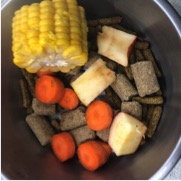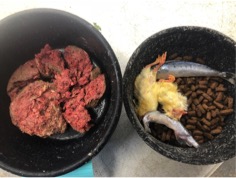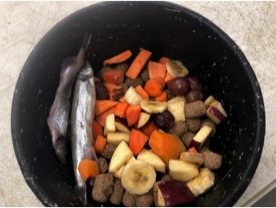

Lehigh Valley Zoo Animal Care Department – Hi everyone! My name is Elyse and I am one of the Keepers and Commissary Managers at the Lehigh Valley Zoo! Some of you might be asking, what is a commissary manager? Well I am here to tell you just that!
 At the zoo, there are two Commissary Managers – myself and Erika. Our day starts out in the barnyard and goat areas of the Zoo. We are responsible for caring for, cleaning, and feeding all the animals that live in those areas! When all of that is complete, we go to do one of the most important parts of our job. One of our job’s most important part is to make the diets for all the animals at the zoo. We make diets for our smallest to some of our largest animals at the zoo, including our lorikeets, mongoose lemurs, raccoon, and even our lynxes! Most of the diets are made down at the Animal Care Commissary, also known as the ACC. The ACC is where all the magic happens. All the things we need to make the diets is stored down there. This includes grain, produce, meat, fish, rodents, and chicks. All the animals are on a specific diet based on their specific needs. We have different types of grain for different animals. We use 24 different types of grain for all the different kinds of animals as the zoo. Not all the animals get grain, just like not all the animals get fruits and veggies as a part of their diet. For example, our porcupines, Gavin and Amber, get rodent block grain, apples, carrots, and sweet potatoes! All these items are not only super healthy for them, but the grain and these harder fruits and veggies help maintain their teeth. Porcupines are in the rodent family, so their teeth are constantly growing, and their diets help naturally keep them short. To the right is a picture of Amber’s diet. She gets rodent block grain, leaf eater grain, carrots, apples, and corn. Amber loves corn! Amber gets half her diet in the morning and the rest when the zoo closes. The reason we do this is so that she gets socialized with her keepers. This socialization benefits Amber, because she is the oldest North American Porcupine, and allows for a stronger relationship between her and her keepers.
At the zoo, there are two Commissary Managers – myself and Erika. Our day starts out in the barnyard and goat areas of the Zoo. We are responsible for caring for, cleaning, and feeding all the animals that live in those areas! When all of that is complete, we go to do one of the most important parts of our job. One of our job’s most important part is to make the diets for all the animals at the zoo. We make diets for our smallest to some of our largest animals at the zoo, including our lorikeets, mongoose lemurs, raccoon, and even our lynxes! Most of the diets are made down at the Animal Care Commissary, also known as the ACC. The ACC is where all the magic happens. All the things we need to make the diets is stored down there. This includes grain, produce, meat, fish, rodents, and chicks. All the animals are on a specific diet based on their specific needs. We have different types of grain for different animals. We use 24 different types of grain for all the different kinds of animals as the zoo. Not all the animals get grain, just like not all the animals get fruits and veggies as a part of their diet. For example, our porcupines, Gavin and Amber, get rodent block grain, apples, carrots, and sweet potatoes! All these items are not only super healthy for them, but the grain and these harder fruits and veggies help maintain their teeth. Porcupines are in the rodent family, so their teeth are constantly growing, and their diets help naturally keep them short. To the right is a picture of Amber’s diet. She gets rodent block grain, leaf eater grain, carrots, apples, and corn. Amber loves corn! Amber gets half her diet in the morning and the rest when the zoo closes. The reason we do this is so that she gets socialized with her keepers. This socialization benefits Amber, because she is the oldest North American Porcupine, and allows for a stronger relationship between her and her keepers.

Some animals that do not receive any produce are the carnivores that live at the zoo. One example is our lynxes! Our lynxes get exotic feline grain, Nebraska feline meat, and a variety of “items.” These items can include rats, chicks, capelin, smelt, sardines, and even mackerel. On the right is an example of the Lynx diet for Sasquatch and Selma. They get the bowl of grain chicks/fish in the morning, and they eat get a bowl of the Nebraska meat in the evening when we close. Our lynxes love chicks but are not the biggest fans of clams.
 Some animals get a combination of grain, produce, and meat or items! These animals are omnivorous. One of our most adorable omnivorous animals is our raccoon, Titan. Pictured on the right is Titan’s diet. He gets omnivore grain, a variety of produce including apples, grapes, sweet potato, and carrots. Titan will also get two items every day! He loves to eat capelin and chicks! He also might get a variety of fish, just to change up his diet a little bit! Giving new food items to any of our animals is very exciting because they might love the new food, or they might hate it. Our most charismatic animals, including Titan, will definitely let us know if they love it or hate it! If he is not a fan of a food item, he will hide it somewhere in his exhibit for his keepers to find!
Some animals get a combination of grain, produce, and meat or items! These animals are omnivorous. One of our most adorable omnivorous animals is our raccoon, Titan. Pictured on the right is Titan’s diet. He gets omnivore grain, a variety of produce including apples, grapes, sweet potato, and carrots. Titan will also get two items every day! He loves to eat capelin and chicks! He also might get a variety of fish, just to change up his diet a little bit! Giving new food items to any of our animals is very exciting because they might love the new food, or they might hate it. Our most charismatic animals, including Titan, will definitely let us know if they love it or hate it! If he is not a fan of a food item, he will hide it somewhere in his exhibit for his keepers to find!
These are only a few of the many diets we take care of at the zoo! I hope you enjoyed learning about the diets for some of my favorite animals! We hope to see you at the zoo!
Written by Elyse Vogel
Animal Keeper & Commissary Manager
Lehigh Valley Zoo | Schnecksville, PA